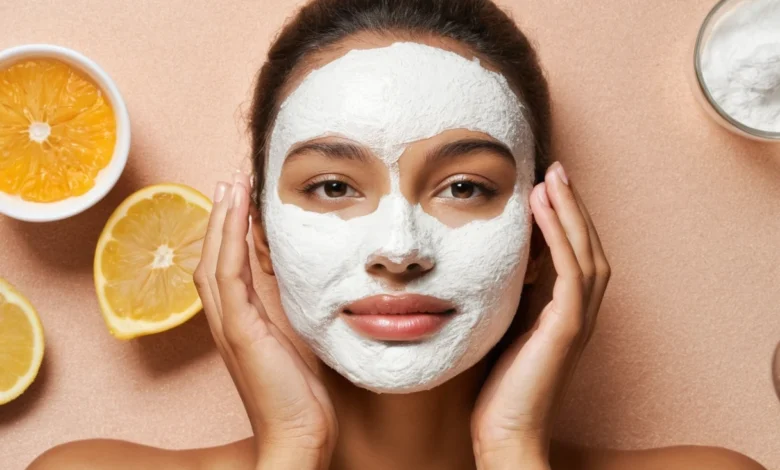How to Exfoliate Your Skin Properly: Tips for a Radiant Glow

Exfoliation is one of the key steps to achieving healthy, glowing skin. It helps remove dead skin cells, unclogs pores, and reveals the fresh, smooth skin underneath. But the process of exfoliating needs to be done correctly, especially considering skin type and the products used, to avoid causing irritation or damage. Whether you’re new to exfoliation or looking to refine your routine, this guide will help you exfoliate properly and maintain a radiant glow.
In this blog, we’ll dive into expert tips for exfoliating effectively, common FAQs, and skincare routines designed for different skin types to ensure that your skin is always glowing and healthy.
1. Understanding the Importance of Exfoliation
Exfoliation is the process of removing dead skin cells from the surface of your skin. Over time, these dead cells can accumulate, causing your skin to look dull and leading to clogged pores, rough texture, and breakouts. Exfoliating regularly helps to:
- Unclog pores
- Smoothen skin texture
- Improve the absorption of skincare products
- Brighten your complexion
FAQ: How often should I exfoliate my skin?
For most skin types, exfoliating 1-2 times per week is ideal. However, this can vary depending on your skin type and the products you’re using.
2. Types of Exfoliation: Physical vs. Chemical
Exfoliation can be categorized into two types: physical and chemical. Each has its own benefits, and the choice depends on your skin type and preference.
- Physical Exfoliation: Involves scrubs or tools that physically slough off dead skin cells. These include products with small grains or exfoliating brushes.
- Chemical Exfoliation: Uses acids or enzymes to break down and dissolve dead skin cells without the need for scrubbing. Common ingredients in chemical exfoliants include glycolic acid, lactic acid, and salicylic acid.
Pro Tip: If you have sensitive skin, consider opting for chemical exfoliants as they tend to be gentler on the skin compared to physical scrubs.
3. Choosing the Right Exfoliant for Your Skin Type
Not all exfoliants are created equal, and it’s crucial to select the one that suits your skin type to prevent irritation or breakouts. Here’s how to choose the right exfoliant for your skin type:
- Dry Skin: Chemical exfoliants containing alpha-hydroxy acids (AHAs) like glycolic acid work well for dry skin as they remove dead cells while boosting hydration. Avoid harsh scrubs, which can further dry out your skin.
- Oily/Acne-Prone Skin: For oily skin, beta-hydroxy acids (BHAs) like salicylic acid penetrate deep into the pores to remove excess oil and prevent breakouts. Exfoliating gels and pads with BHAs are ideal for this skin type.
- Sensitive Skin: Use a mild exfoliant with lactic acid or polyhydroxy acids (PHAs), which gently remove dead skin without causing irritation. Avoid physical exfoliants with rough particles.
FAQ: Is it okay to use both physical and chemical exfoliants in my routine?
Yes, but be cautious. Use one type at a time to avoid over-exfoliation and irritation. For example, if you use a chemical exfoliant one day, skip the physical exfoliant that week.
4. How to Exfoliate Properly: Step-by-Step Guide
Exfoliating is more than just applying a product and rinsing it off. Here’s a step-by-step guide to ensure you’re exfoliating correctly:
- Cleanse Your Skin First: Start with a gentle cleanser to remove any makeup, dirt, or oil before exfoliating. This helps the exfoliant work more effectively.
- Apply the Exfoliant Gently: Whether you’re using a scrub or a chemical exfoliant, be gentle. For physical exfoliants, use circular motions and avoid rubbing too hard, especially on sensitive areas. For chemical exfoliants, follow the product instructions carefully.
- Focus on Problem Areas: Pay attention to areas where you have rough or uneven texture, like around the nose, chin, or forehead. These areas may need a bit more attention.
- Rinse and Moisturize: After exfoliating, rinse thoroughly with lukewarm water and pat your skin dry. Follow up with a hydrating moisturizer to lock in moisture and protect your skin barrier.
Pro Tip: If you’re using a chemical exfoliant, make sure to use sunscreen daily, as your skin may be more sensitive to the sun.
5. Avoid Over-Exfoliation
While exfoliating is beneficial, overdoing it can harm your skin. Over-exfoliation can lead to redness, irritation, and even damage your skin’s protective barrier, resulting in dryness and increased sensitivity.
- Signs of Over-Exfoliation: Redness, peeling, increased breakouts, or a burning sensation are common indicators.
- Solution: Cut back on exfoliating and switch to a gentler product. Give your skin time to heal before resuming your exfoliation routine.
FAQ: What should I do if I over-exfoliate?
If you’ve over-exfoliated, stop exfoliating immediately and focus on repairing your skin barrier. Use soothing products like aloe vera, hydrating serums, and barrier creams until your skin recovers.
6. Exfoliating Different Body Parts
While we often focus on exfoliating the face, other areas of the body also need attention. Exfoliating your body helps with smooth skin texture and can prevent issues like ingrown hairs. Here’s how to approach it:
- Body: Use a body scrub or a loofah in the shower to exfoliate. Pay special attention to rough areas like elbows, knees, and feet.
- Lips: Gently exfoliate your lips with a soft scrub or a toothbrush to remove dead skin and prevent chapped lips.
- Scalp: Regular scalp exfoliation helps remove buildup from hair products, dead skin cells, and oils. Use a scalp exfoliator or a gentle scalp scrub to stimulate healthy hair growth.
Pro Tip: Avoid using the same exfoliant on your body and face. Body exfoliants are usually stronger and can be too harsh for the delicate skin on your face.
7. Post-Exfoliation Care
After exfoliating, it’s essential to take care of your skin to keep it hydrated and protected. Here’s what you should do:
- Moisturize Immediately: Apply a hydrating moisturizer or serum right after exfoliating to replenish your skin’s moisture barrier. Look for ingredients like hyaluronic acid, ceramides, and glycerin.
- Soothe Your Skin: If your skin feels sensitive after exfoliation, use calming products with aloe vera, chamomile, or oatmeal to reduce redness and irritation.
- Protect Your Skin: Always apply sunscreen during the day after exfoliating, as your skin will be more sensitive to UV rays.
FAQ: How can I ensure my skin stays hydrated after exfoliating?
Use a hydrating serum and follow with a moisturizer that locks in hydration. Drinking plenty of water also keeps your skin healthy and hydrated from within.
8. Natural Exfoliants: Are They Effective?
Many people turn to natural exfoliants like sugar, coffee grounds, or oatmeal for a gentler and eco-friendly alternative. While these can be effective, they must be used carefully.
- Sugar: Acts as a natural exfoliant for the body but can be too abrasive for the face, so use it sparingly.
- Oatmeal: Great for sensitive skin, oatmeal exfoliates and soothes irritation. It’s gentle enough for the face and body.
- Coffee Grounds: An excellent choice for body exfoliation, especially for areas like thighs and elbows, but it may be too harsh for delicate facial skin.
Pro Tip: When using natural exfoliants, mix them with a moisturizing base like honey or yogurt to make the exfoliation process gentler.
Conclusion: Exfoliate for Radiant, Healthy Skin
Exfoliating your skin properly is the key to maintaining a smooth, radiant complexion. By choosing the right exfoliant for your skin type, following a proper exfoliation routine, and avoiding over-exfoliation, you can achieve glowing, healthy skin. Remember to moisturize and protect your skin after each exfoliation session, and your skin will thank you with a beautiful, fresh glow.





